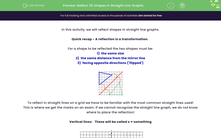In this activity, we will reflect shapes in straight line graphs.
Quick recap - A reflection is a transformation.
For a shape to be reflected the two shapes must be:
1) the same size
2) the same distance from the mirror line
3) facing opposite directions ('flipped')
To reflect in straight lines on a grid we have to be familiar with the most common straight lines used!
This is where we get the marks on an exam. If we cannot recognise the straight line graph, we do not know where to place the reflection!
Vertical lines: These will be called x = something
Horizontal lines: Will be called y = something
Diagonal lines: y = x or y = -x
These are quite commonly used and easy to recognise as the value of x = the value of y
For example, when x = 1, y = 1 and when x = 2, y = 2. Therefore, y = x
We put the straight line graphs together with the reflections.
Let's look at a typical question!
Example
Reflect the shape below in the line x = 2
Answer
We identify the mirror line first.
x = 2 is vertical and cuts through x = 2
Next, we count how many squares each corner is from the mirror line and plot the same distance on the other side.
Do this for all four corners and join together to form the reflection!
Have you got it? Let's try some questions.








